[ad_1]
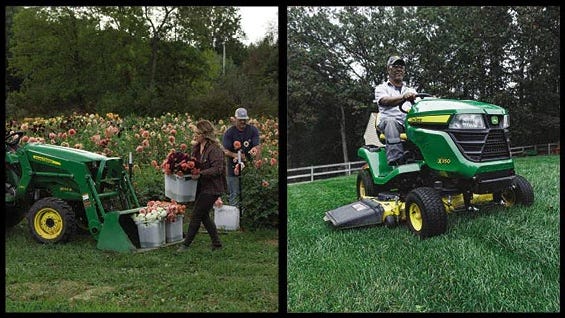
John Deere
As I mentioned in my guide on how to choose a snow blower, I worked for several years in a factory and warehouse that produced powered lawn equipment, including lawn mowers. While my experience is mostly with Cub Cadet, Craftsman, and Troy-Bilt branded equipment, it can be applied to other brands as well since all lawn mowers use the same basic parts and operation principles. In this guide, I’ll explain the different types of lawn mowers you can buy, the pros and cons of gas and battery-powered units, and how to best match a mower to your lawn.
Push and self-propelled mowers
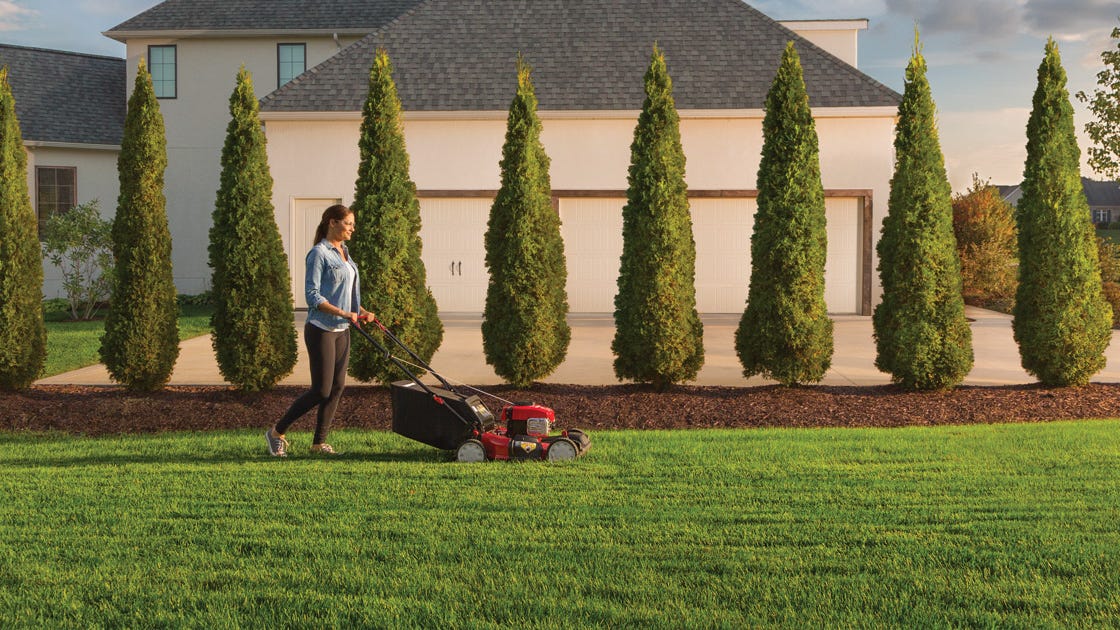
Troy Bilt
If you live in a suburb or small town, you’re probably more familiar with this type of lawn mower than others. Push mowers have a very simple design, since they’re basically an engine mounted to the top of the cutting deck, with wheels and a control handle for maneuvering. This makes them smaller and more compact, which is great news if your garage or tool shed is on the smaller side or has a lot of equipment stored in it.
There are two main types of push mowers: self-propelled and ones you have to push. Self-propelled models have a special transmission that provides power to the rear wheels in order to produce forward momentum. These have become very popular with homeowners, since they don’t require as much effort to operate, which also reduces user fatigue. A self-propelled mower also will have a variable speed clutch, which you can adjust to match your natural walking speed. The downside to a self-propelled lawn mower is they are often much heavier and more expensive than their manual push counterparts, so keep that in mind when comparing models.
Manual push mowers rely on human power to move forward, which means they’re a bit lighter, but that also means that they’re not ideal for lawns with inclines or rough patches; you’ll get very tired very quickly trying to maneuver your manual push mower over bumpy spots and ditches. There’s a sub-type of manual push mower that has seen a resurgence in popularity lately: the manual reel mower. This type of push mower still relies on human power to move forward.
If you choose a gas-powered push or self-propelled mower, there’s a bit more to getting it up and running than you may think. Since these models have two-cycle engines (where a single piston makes two rounds for every single turn of the drive shaft), they require a special mix of gasoline and two-cycle oil to run correctly. This not only gives the engine what it needs for the internal combustion process, it also provides adequate lubrication for all moving parts, because, unlike a typical four-stroke engine, a two-stroke model doesn’t have a dedicated reservoir for circulating oil. Fortunately, you can buy pre-mixed fuel from places like Home Depot and Lowe’s if you aren’t comfortable mixing the two yourself. And buying the pre-mix means you won’t have to worry about storing lots of different chemicals for just a few pieces of equipment.
Reel mowers are basically a set of three to seven blades mounted on a rotating barrel, a pair of wheels, and a control handle. They were first invented in 1868, but didn’t catch on until the post-WWII suburban boom. Most reel mowers measure just 16 inches across, which means they’re best suited for very small lots (think .25 acres or less). As more homeowners look for environmentally friendly and carbon-neutral lawn care solutions, reel mowers like the Troy-Bilt TB16R have been favored, since they don’t require fuel or batteries to run or any maintenance other than blade sharpening.
Riding mowers
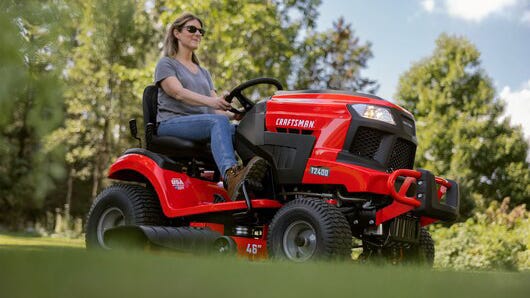
Craftsman
Riding lawn mowers are just what they sound like, though they are sometimes also called lawn tractors. They’re all mostly very similar in design, but there is a sub-type called zero turn, which we’ll go over in more detail in a bit. Riding mowers are best suited for lawns that are an acre or larger, since they have larger engines and cutting decks that range from 30 to 72 inches. Most larger suburban lawns will benefit the most from a cutting deck that ranges between 30 and 46 inches.
Riding mowers outfitted with 30-inch cutting decks are known as “mini riders,” since they’re more compact than full-size models. These kinds of riding mowers are great for yards that are a touch too large for a push mower but aren’t big enough to justify buying a full-size rider. The more compact build is great for storing in smaller garages and tool sheds, but even though they’re small, that doesn’t mean they skimp out on power.
The Troy-Bilt TB30B, which I featured in my list of the best riding lawn mowers, is built with a 10.5HP Briggs and Stratton mower, which provides enough power to handle lawns between .75 and 1 acre as well as inclines and any rough patches your yard may have. It has enough oomph for hauling a small wagon for moving tools and gardening supplies, a lawn sweeper for cleaning up grass clippings, or a spreader accessory to re-seed patchy areas of your lawn.
Full-size riding lawn mowers, like our No. 1 pick, the Husqvarna YTH18542, are most often equipped with either a 42- or 46-inch cutting deck that is outfitted with two sets of cutting blades. This gives you a more even cut on each pass, and the midsize cutting decks still give you enough maneuverability to get around most obstacles, such as trees, lampposts, and mailboxes. Larger decks, 50 to 72 inches, give the mower a wider turn radius, so they’re much more suited to yards with either established, mature trees or minimal obstacles, since it will be a bit more tricky to maneuver around them. Larger cutting decks also may have an array of three or four sets of blades, which ensures a neat and even cut on every pass, but means there’s a bit more maintenance needed to keep everything in good working order.
While gas-powered engines are by far the most common in riding mowers, there are several electric models you can choose from if you’re looking to either cut down on how much maintenance you choose to perform or for a more eco-friendly solution to caring for your lawn. Some electric riding mowers, like the Cub Cadet XT1 Enduro LT, have built-in batteries that you can recharge with a regular extension cord. While others like the Greenworks Pro 60V CrossoverT use an array of removable batteries, which are often compatible with other battery-powered lawn equipment from the same brand, like string trimmers and leaf blowers. And this is great news if you’re looking for something that will be easier to integrate into your workshop, since you won’t have to worry about buying and maintaining a special battery for each piece of equipment.
There are more features to consider when shopping for a riding lawn mower, such as transmission types, attachments and proprietary features, and gas engines versus electric motors. But we’ll go over those in-depth in their own sections.
Zero turn and commercial mowers
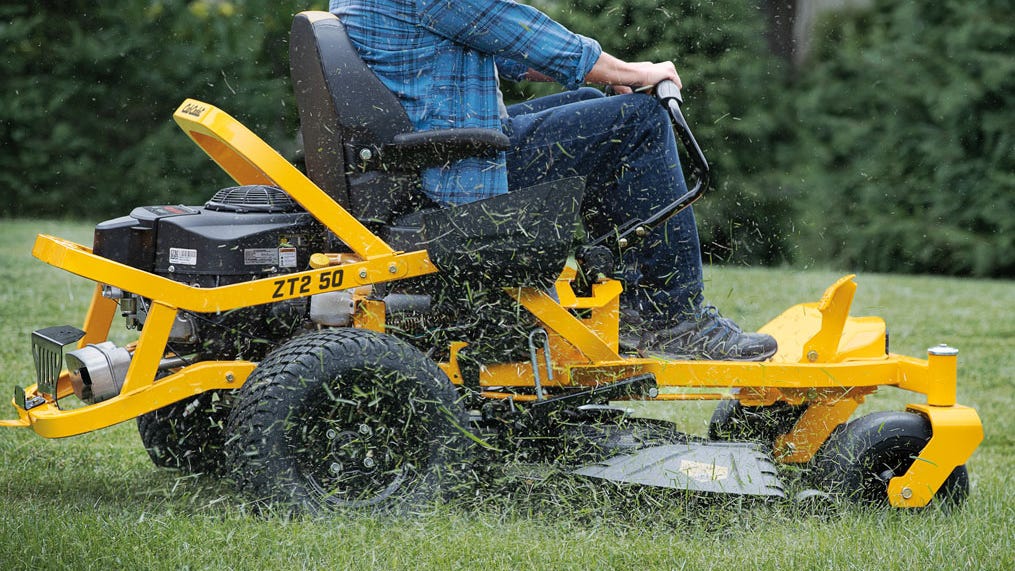
Cub Cadet
Zero turn mowers are a sub-type of riding lawn mowers, so called because they have a zero-inch turn radius. By using either rear wheel as a pivot point, you can spin on the spot, which makes it very easy to maneuver around lots of obstacles and oddly shaped sections of your lawn. Zero turn models are a bit trickier to learn how to drive, since most use a lap bar system for steering; though there are models that use traditional steering wheels, they’re much more expensive.
Zero turn models also require more storage space, since they tend to be larger than traditional riding mowers. While their cutting decks are usually around the same size (42-50 inches are the most common deck sizes for zero turns), their frames are much larger, so they can accommodate features like roll protection bars and sunshades. So you’ll have to measure a section of your garage or tool shed (as well as the door width) to make sure you have enough space for a zero turn.
Commercial grade mowers are designed and intended for use in large-scale landscaping and lawn care for golf courses, city maintenance, and sports complexes. But if you live in a rural area and have a large plot of land to take care of, a commercial mower can be a great piece of equipment to have in your workshop. With commercial grade mowers’ larger cutting decks of 60 or 72 inches, you can make short work of multi-acre properties, and they often have either zero turn capabilities or very-small-turn radiuses so you can easily work around stands of trees, outbuildings, and fenced-in areas.
The biggest drawback of commercial grade lawn mowers is their staggering cost. I featured the John Deere 1570 TerrainCut as my pick for the best commercial mower on our list of the best riding mowers you can buy, and it starts at almost $28,000. There are financing options available, but that’s still quite a bit of cash to spend on lawn care. Places like Home Depot and Lowe’s sell a few commercial grade models, like the DeWalt Z260, which are a bargain, comparatively. But they are still a hefty investment at $8,000-$10,000.
Robot mowers
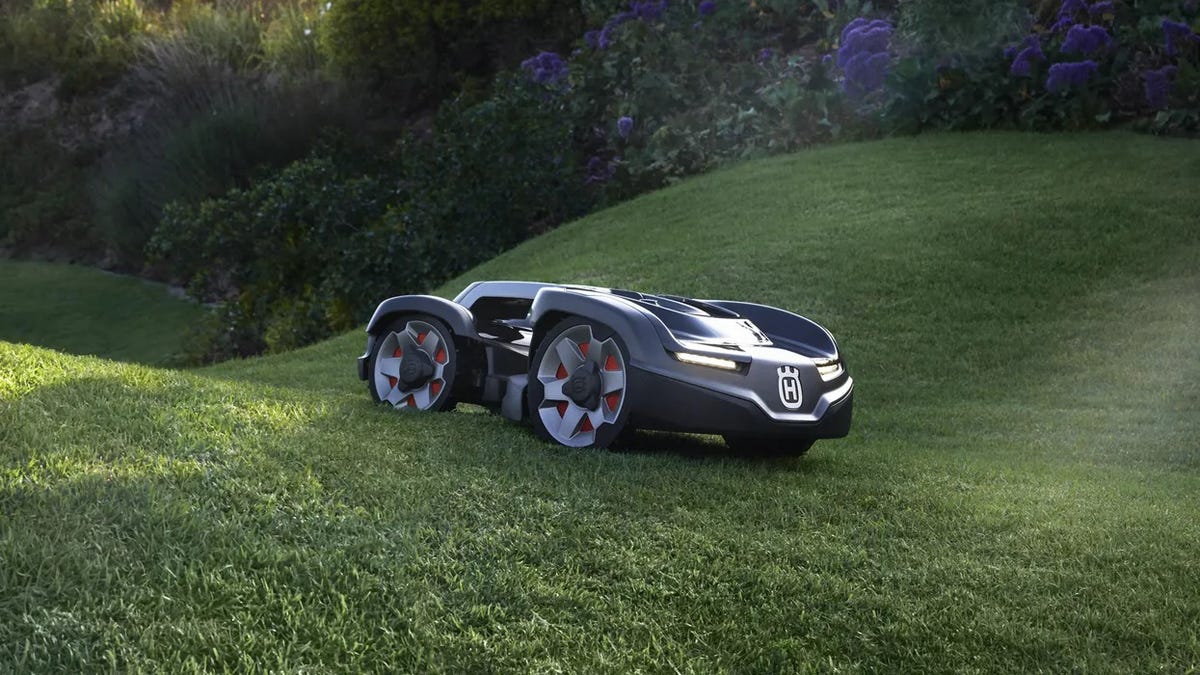
Husqvarna
Robot mowers are a relatively recent innovation in lawn care. They operate much in the same way as robot vacuums and mops, autonomously going about maintaining your lawn with or without a set schedule. Many robot mowers work with Bluetooth connections, GPS tracking, and companion apps to let you set operation times and no-go zones and check on things like battery levels and other statuses so you can plan maintenance.
These models are almost invariably battery-powered, which means you have to also maintain a base station for the unit to travel to and from for both battery charging and storage. The best place for a base station is somewhere that is relatively safe from the elements (to protect electrical contacts and wiring from moisture damage) and open enough for safe and simple maneuvering when it’s time for the robot to start mowing. Many robot mowers also require you to set up a boundary wire similar to an invisible fence for pets. The mower detects the signal from this wire and stays within your yard, so you never have to worry about it accidentally driving into the street or over your neighbor’s prized tomato plants.
Due to the limited amount of boundary wire as well as shorter runtimes and very small (8 to 10 inches) cutting widths, robot mowers are better suited for lawns that are about .5 acres or less. You’ll also have to get used to the idea of a mower that doesn’t make neat, organized passes over your lawn. While there are a few models out there that use a guide wire for precise travel paths, most robot mowers mow in a random pattern similar to a robot vacuum bustling around your living room and bumping into your dog. That may sound stressful and like a recipe for lawn care disaster, so manufacturers have accounted for this. Robot mowers have shorter runtimes of about an hour, but they also mow much more frequently than you would with a push or riding mower. This means that while it may not get to every part of your lawn during a particular mowing session, it will get to it the next time, so you’ll always have an evenly mowed lawn and one that you never have to lift a finger to maintain.
Since robot mowers are such a new technology, like commercial and zero turn mowers, they’re a pricey investment. The Worx Landroid L, which I featured as my pick for the best robot mower, starts at around $2,100, making it one of the more affordable options out there. Others, like the Husqvarna AutoMower 450X retail for around $4,100, and have premium features like Alexa compatibility for voice control, anti-theft alarms, and the ability to program different cutting schedules and pattern profiles for different sections of your lawn for the perfect cut every time.
If you purchase a robot mower directly from brands like Husqvarna, you also may be able to opt for professional installation of the guide or boundary wires and base station, and other professional help setting up your new mower for the first time. I highly recommend spending the extra money for professional installation. That way, you know for sure things are set up and connected correctly, and you don’t have to spend a whole weekend frustrated and cranky because you have to dig trenches for 1,000 feet of wire.
Transmission types
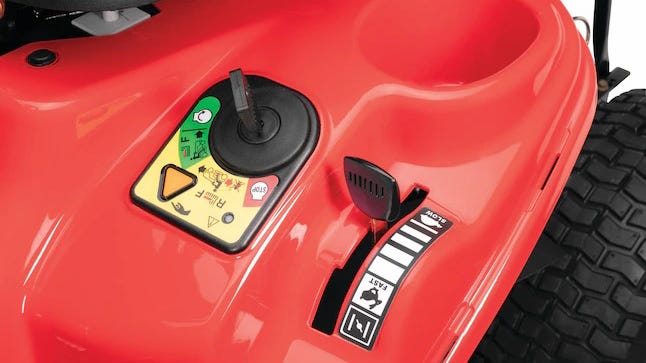
Troy Bilt
This section mostly applies to riding mowers, though push and self-propelled models also have different transmission types like adjustable throttles or single-speed. You may be more familiar with the variable speed manual transmission type; the riding mower will have two separate levers, one for adjusting the cutting height and another for setting the forward and reverse speeds.
These transmission types are great since you can “set and forget” your speed and focus more on obstacles, pets, and people that may be nearby. However, they also can be trickier to maneuver, since you really don’t have a way to control your momentum other than a single brake pedal. The variable speed manual transmission is a relatively simple part, so mowers built with one tend to be on the more affordable side.
The other transmission type is the hydrostatic variable speed. You can think of it as similar to automatic transmission in cars and trucks: you just press the pedal and the transmission does the work of shifting gears for you. This makes driving your lawn mower similar to driving a car, which also makes them easier to get used to. Instead of control levers, a hydrostatic mower will have forward and reverse pedals, and the harder you press them, the faster you go. This makes it very intuitive to maneuver around obstacles and tricky terrain, since you don’t have to fully stop your mower, manually adjust your speed, and then resume your path. Hydrostatic transmissions are a more complicated part to build, so prepare for that to be built in to the final retail price of your riding mower.
Gas engines vs. electric motors
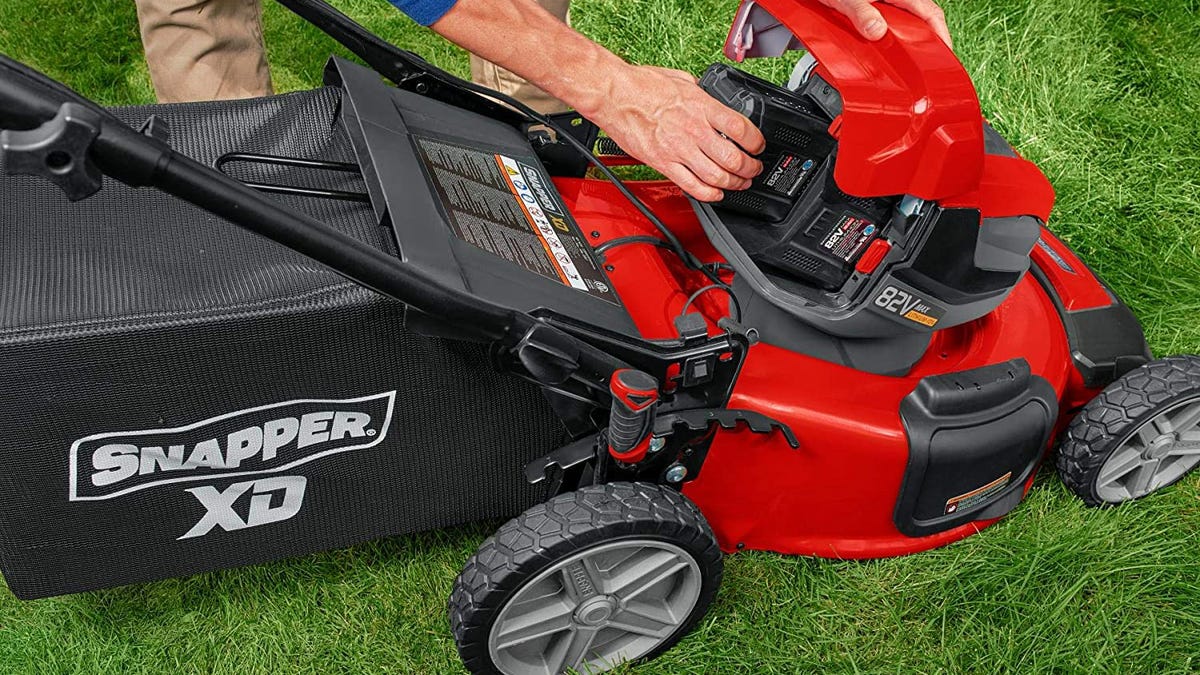
Snapper
As I mentioned before, gas-powered mowers are by far the most common type you’ll find when shopping. They’re relatively inexpensive to produce, since the technology is well-established, and their engines offer more horsepower for handling inclines and large lots. And while you might save a bit of cash on your initial purchase, you’ll end up spending more on maintenance throughout the life of your mower.
Gas-powered engines require regular maintenance, which we’ll go over in more detail later, in order to stay fuel efficient and powerful enough to actually cut your grass. The costs for things like oil, replacement filters, and spark plugs can add up over time, so make sure you account for that when shopping for a new lawn mower.
Electric-motor lawn mowers have become very popular in recent years, not only because they don’t require nearly as much maintenance as their gas-powered counterparts, but also because they’re a more eco-friendly solution to lawn care. Since they don’t burn fuel, they don’t produce any emissions, which is great news for anyone who lives in neighborhoods or under the mandates of Homeowner Associations that restrict that sort of thing. They’re also much quieter than gas models, so if you need to mow in the early morning or late evening, you won’t have to worry about bothering your neighbors.
Electric mowers aren’t quite as powerful as gas models, but they still have enough juice to mow lawns up to 2 acres (depending on the model) or haul wagonfuls of tools, mulch, or potting soil. Many also use the same types of batteries that are found in equipment like string trimmers and leaf blowers, so if you buy the same brand, you’ll be able to use the same batteries. This means you won’t have to purchase and maintain special chargers and batteries for a single piece of equipment, making them easier to integrate into your workshop. That also means that you can keep multiple batteries at-the-ready to swap out if you need to use your mower longer than the usual 60 minute runtime you can get out of a fully charged unit.
Electric mowers are a relatively new technology, so they tend to be more expensive, but you can find electric push mowers, like the Ego Power+, for less than $500. Unfortunately, electric traditional riders and zero turns are going to be about $1,000-$1,500 more than their gas-powered counterparts, but the trade-off is that you’ll get longer runtimes of about 90 minutes.
Storage and maintenance considerations
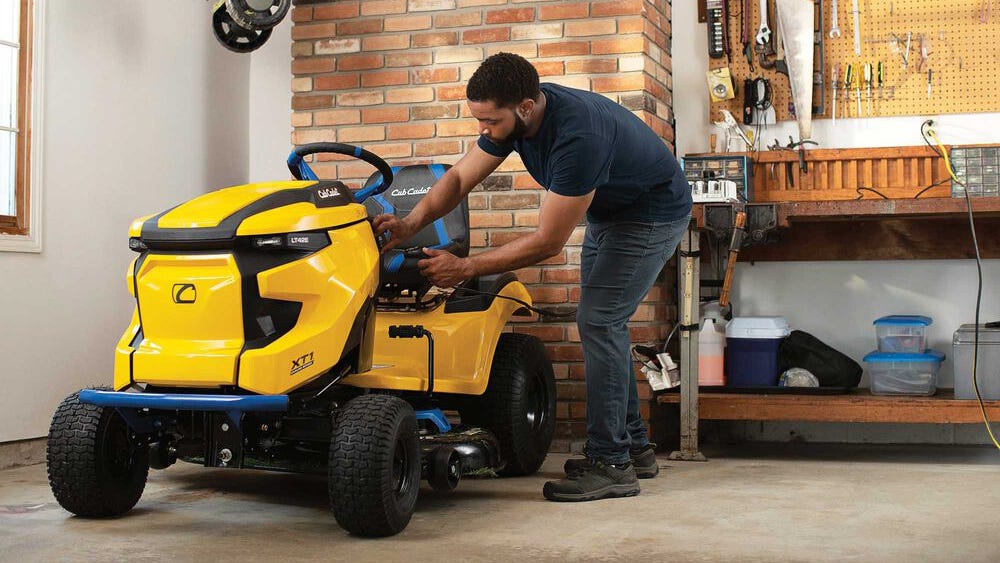
Cub Cadet
Regular maintenance and proper storage are two of the best ways to extend the life of your lawn mower and keep it in good working order season after season. Gas-powered models require oil and filter changes at the beginning of each mowing season as well as blade sharpening and fuel treatments. Additives like STA-BIL protect gasoline that may be in the holding tank or fuel lines from being contaminated with moisture from rain, snow, and even humidity. If there is water mixed with your fuel, the engine won’t run properly, and you could severely damage internal parts such as pistons. Regular oil and filter changes keep debris from building up inside the engine, which improves fuel efficiency and maintains consistent horsepower.
Electric lawn mowers don’t have traditional engines to take care of, but that doesn’t mean they don’t need regular service routines as well. Before you mow your lawn for the first time in the spring, you should thoroughly inspect the battery connections, housing, and wiring of your electric lawn mower for corrosion or other damage. If you see corrosion on the battery contacts, you can clean it off with a wire brush and some CRC Electronics Cleaner
Make sure you wear gloves and safety glasses to protect your skin and eyes from flying debris and splashing chemicals. Once the contacts are fully dry, you can insert the battery and use your mower. If you see any damage to the wiring, do not try to repair it yourself. Not only could this void your warranty or cause more damage, you also could get some serious injuries from accidental electric shock; check your operator’s manual for customer service contact numbers and warranty information. You may be able to get replacement parts sent out to you for free, or you’ll be directed to a local repair center to replace the damaged parts.
Blade sharpening
Blade sharpening is a lot easier and faster than you think it is, but it can be an intimidating process if you’ve never done it before, especially if you have a riding or zero turn mower. For push and self-propelled models, make sure the gas tank is empty (or very close to empty) and that the rip cord is disabled. That way, you won’t have any accidental startups that can lead to lost fingers. You’ll then flip the entire unit over and locate the blade spindle and holding bolt. You’ll use a ⅜-inch socket wrench to remove the bolt, paying special attention to how it’s threaded; some spindle bolts are reverse-threaded. This means that instead of “righty tighty, lefty loosey,” it’s the opposite, and you’ll turn it to the left to tighten or to the right to loosen.
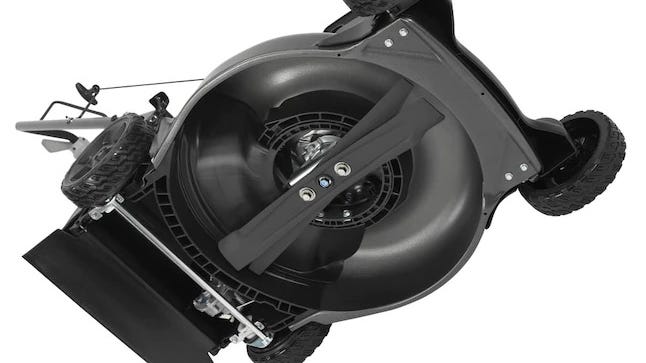
Honda
Once the bolt is removed, you can take the blade off of the deck. You’ll want to closely inspect the entire blade, not just the cutting edge, for damage. Severe cracks and nicks can’t be repaired on your own, so you may have to purchase entirely new blades. You can find the correct replacement part number in your operator’s manual, or on the mower brand’s website; places like Lowe’s and Home Depot often carry aftermarket parts, so you most likely won’t have to find a special shop for new blades.
For reel mowers, you’ll be able to sharpen the blades while they’re still in the frame. You’ll run a flat metal file over each cutting edge a few dozen times, carefully rolling the barrel to sharpen the next blade. Make sure you chock the wheels with something to keep the reel mower from creeping forward or backward while you work; you don’t want to start filing and have the mower move, causing you to get cut.
For riding and zero turn lawn mowers, you’ll have to remove the entire cutting deck to safely access the spindle bolts and blades. The most common wrench size you’ll need for the holding bolts is ¾ inches, but your mower may have larger or smaller ones. You’ll also probably have to disconnect several belts and cables and remove cotter pins. You can either follow an official assembly manual from your lawn mower’s manufacturer, or you can follow along with a video tutorial; there are thousands on YouTube, and you can search your specific make and model to be extra sure you’re doing things correctly.
Once you have the deck removed (and all bolts, washers, and cotter pins tucked away so they don’t get lost), you’ll remove the blades from the spindles like you would on a push mower. Again, paying attention to how each bolt is threaded. If you’re having trouble getting bolts to come loose, a spritz of a rust penetrating oil like WD-40 will often do the trick.
To actually sharpen your blades, all you need is a vise and a flat metal file. You’ll first secure the blade in the vise, then set your file to the angle of the cutting edge, running it along the length of the blade. You don’t have to apply a lot of pressure, and you don’t need your blades to be razor sharp, either. A few dozen passes along each cutting edge should bring your blades back to true; you can test the sharpness by running a sheet of paper along the cutting edge. As long as it makes a mostly clean cut, you’re good to put the blades back on your mower.
When you get ready to put your gas-powered lawn mower into storage for the winter, you’ll want to add the directed amount of STA-BIL fuel treatment to the gas tank, start the engine, and let it run in a well-ventilated area for about five minutes. This ensures that the chemicals get through all parts of the engine and every fuel line so you don’t get pockets of moisture or stale fuel. You also should invest in a cover for your push, riding, or zero turn mowers to keep dust and debris from working their way into the engine compartment.
For electric mowers, you’ll want to do a final inspection for cracks, corrosion, and other damage, since cold weather can widen splits in plastic parts, while salt and snowmelt can make metal parts rust very quickly. Once you’ve looked everything over, remove the battery to prevent it from leaking inside the mower and causing damage. If you can’t remove the battery, try to place some foam board insulation around it to keep out as much cold air as possible; the battery will naturally drain over time if the mower isn’t regularly used, but by insulating it from the worst of cold weather, you can slow down the process so you don’t have to worry about replacing a dead battery come springtime. And like gas models, you’ll want to invest in a cover to protect from debris.
Budgeting for a new lawn mower
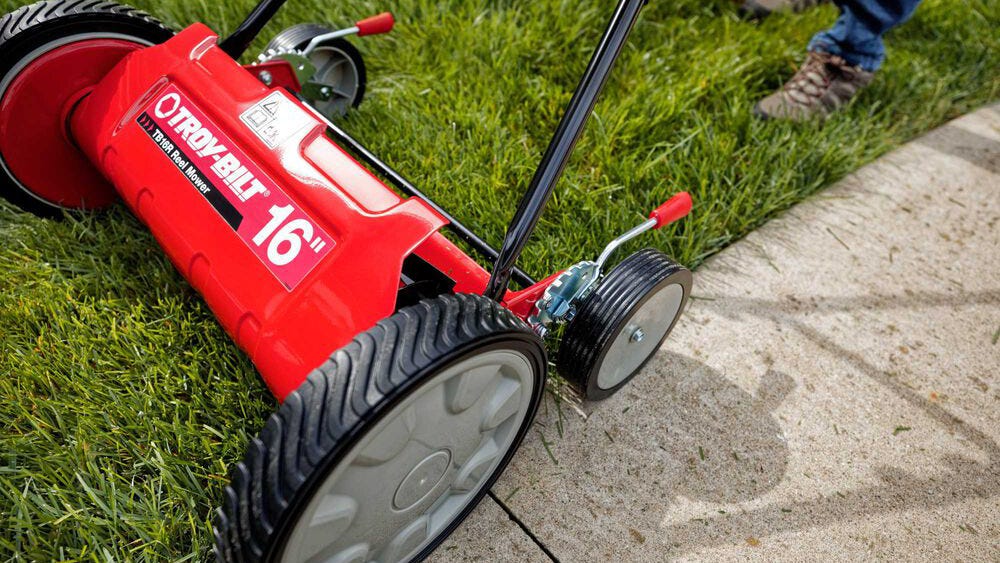
Troy Bilt
I’ve made mention in each previous section of how much to expect to pay for various types of lawn mowers, and that’s because there really isn’t such a thing as a budget-friendly lawn mower, unless you’re looking at manual reel mowers; there are simply expensive and not-as-expensive options.
A manual reel mower, with its extremely stripped-back and simplified design, will retail for under $200, which is great if you have a tiny yard and don’t have a ton of extra money to spend on a new mower. Push mowers can be found within the $300-$500 range, while self-propelled models can cost as much as $1,000.
Riding lawn mowers have a fairly wide range of prices from just under $2,000 for a residential mini rider to the aforementioned $28,000 for commercial grade models. You can expect to pay about $2,500 for a decent, traditional riding mower that will tick most of your must-have boxes, but if you want all the bells and whistles, you’ll have to pay almost $4,000. Zero turn mowers are the most expensive kind of riding mower, with base models retailing for around $3,500 and premium models selling for as much as $8,000.
Robot mowers retail anywhere from $2,000-$4,000 before accounting for the cost of any sort of installation service. This includes the mower itself, the base station, and boundary or guide wires to set up around your lawn.
There are factors that can affect the price of a lawn mower, such as whether it has a gas engine or an electric motor, premium features like cruise control or USB charging ports for your phone, the transmission type, and even which brand you choose. So make sure you account for everything you need your mower to do when sitting down to make a budget before shopping.
It’s important to finalize a budget before you even start looking at lawn mowers, not only to keep you from accidentally overspending, but to also narrow down your choices. A solid budget also will let you get the most value for your money, which means you can find a mower that not only covers the basics, but you also may be able to get a few extra perks like a USB charging port or a larger cutting deck to save you a bit of time when it’s Mowing Day.
Conclusions
You’ve been given a staggering amount of information, but it’s important stuff to know so you don’t end up buying a mower that doesn’t do what you need it to or that you end up hating because it’s too big for your garage or a hassle to maintain. Knowing what types of mowers there are and how they work makes it easier to find the perfect fit for your lawn so it not only looks great when you cut your grass, but also lets you get the most work done in the least amount of time.
What is the best lawn mower to buy?
That’s a pretty objective question, but I’ve got a short list of picks covering a wide variety of use cases:
The Husqvarna YTH18542 is my pick for the best traditional riding mower, while the Cub Cadet Ultima ZT1 is the best zero turn model. If you need a push mower, the Honda HRN 166cc model is the best one, while the Ego Power+ is the perfect electric mower. And if you really like the idea of a robot mower, the Worx Landroid L is my top pick.
Do new lawn mowers require assembly?
Most riding mowers come almost fully assembled if you order them directly from the brand retail site, and you’ll just have to attach the seat and steering wheel; which is easy enough with a socket wrench. If you buy from a store like Home Depot or Lowe’s, you might not even have to do that.
However, if you want a new push mower, you’ll have to block out an afternoon to put it together, since in order to fit into the shipping box, it has to be left in pieces. But don’t worry, you won’t have to know how to connect a motor to the blade spindle, though you will have to set up the control handle and attach the wheels.
How do you start a mower for the first time?
For push and self-propelled mowers, you’ll want to locate the priming button on the motor and push it 3 times. This provides the engine with enough fuel to get started since they still use a carburetor rather than a fuel-injection system. Then you’ll either press the start button or yank on the rip cord to get the engine running.
For riding mowers, you’ll sit in the seat to activate the safety switch, then press on the brake pedal and push the throttle lever all the way forward to the “choke” setting. You’ll then turn the key in the ignition, and when the engine starts up you’ll let it run for 30 seconds before moving the throttle lever from “choke” to your desired level. Then you can release the parking brake and get mowing!
[ad_2]
Source link



